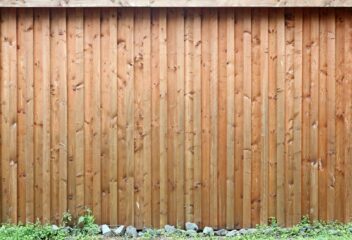
Black doesn’t often come to mind with wood staining projects. Stains exist to bring out the beautiful aesthetics of wood, highlighting them, while possibly shifting their color tone. With darker stains, the heavy and regal qualities of wood stand out, but wouldn’t black just mask the beauty of the wood?
The truth is that black stains do exist. While you may not choose a black stain for an expensive, luxurious slab of special wood species, there are a variety of refinishing projects or exotic exterior designs that can benefit greatly from a beautiful black stain. Coupled with an increase in design trends toward neutrals, the power of black is “in.”
Understanding the Power of the “Color” Black
Black is an unusual color because it technically isn’t a color. Scientifically speaking, while all other colors correspond to specific wavelengths of light, black is the absence of light. That said, in the design world, black is very much a color that can be used in powerful ways.
Design Color Theory
Color is a subject that has been written about for thousands of years and used for tens of thousands of years before we even had a word for it. Civilization slowly began to learn about the scientific basis of colors, explained by light, but this is only one aspect of its importance. Another important aspect is how color affects us psychologically.
The design world has three main categories responding to color groups that stir up certain feelings and emotions:
Warm
Warm colors include yellow, red, orange and all of their interrelated shades. These kinds of colors evoke strong, energetic emotions. Red, for example, tends to correspond to love and passion, but also danger. Yellow evokes happiness and joy, like being outside in the light of the sun. Orange reminds us of fire, a color of security and warmth.
Cool
Instead of being energetic, cool colors are calming. The main cool colors are blue, green and purple. Blue reminds us of the oceans and sky, evoking peaceful feelings. Green reminds us of the forest and the harmony of nature. Purple, a rare color in nature, was used historically by royalty to create a calming sense of security.
Neutrals
Next are the neutrals, the “wildcard” colors that fill in the gaps left by cool and warm colors. The main neutral colors are brown, white and black. White evokes a soft, almost ephemeral feeling, as the color projects innocence and purity. There’s a reason that religious prophets and depictions of gods are typically dressed in white. Brown takes us back to nature, evoking earthy wholesomeness. It’s a friendly color, and staining wood to bring out its natural brown coloring has been done the world over for millennia.
Finally, there’s black. Power, prestige, sophistication, mystery. For not being a technical color at all, it sure seems to represent a powerful corner of the color world.
Let’s take a look at how black stabilizes a design and how it can be a powerful tool when staining wood for architectural aesthetics.
The Stabilizing Power of Black
Black can readily stand-alone to evoke power and seriousness — think of the various logos that use just black and have a great amount of success and recognition. From Nike to Apple to The New York Times, black is used in different industries to make a powerful statement.
In addition to its standalone properties, black in color design is a stabilizer. It helps to provide contrast to warm and cool colors. In a simple example, think of an all-white house. Every inch of wood is white, with light-colored roofing material. Now, imagine the same white house but trimmed in black. Even though the black is sparse and only in thin areas, it creates a powerful, stabilizing effect that tones down the vast white and forms a more proportional aesthetic.
This same concept can be applied to any wood — furniture, doors or house trim — that might be stained black. It’s unlikely that a design will call for a giant wooden black wall, but what if there were a black-stained piece of furniture against a brightly colored wall? If the furniture were brown, it might look odd or not attract attention at all. However, black makes the furniture pop, so it stands small but strong in contrast to a variety of other colors behind it.
This offers designers a wide variety of applications to create contrast and play with emotion — all with a little black stain.
Why Stain or Restain Wood?
In general, wood is stained to bring out the natural beauty of the wood and preserve it. It can also be used to alter the wood’s natural aesthetics, bring out more of its darkness or highlight its lightness. In overall design, its flexibility can be used for many creative designs.
Alter Aesthetic Style
Altering aesthetics is a big reason for staining. For example, consider a neutral-colored wooden door. It can be stained to be its natural self, to be lighter, or to be darker. Depending on its surroundings, these changes can have a serious effect on the overall design.

Save Money by Refinishing Instead of Replacing Exterior Finishings
A lot of people might see old pieces of wooden furniture as just that — old. They may be chipped, frayed, discolored and, in general, they look like they’re ready for the dump. However, wood always remains wood, even when it has aged. Some sandpaper and a new stain can dramatically transform an old piece of furniture or door into something brand new. This is a powerful tool to repurpose often excellent aged furniture that has just lost its luster.
Preserve Value by Protecting Exterior Finishings from the Environment
Staining doesn’t just improve the characteristics of wood, but it also protects it. This is immensely important for exterior applications. Raw wood attached to a house will degrade both in its color and structure quickly. If a stain is applied, the wood is inherently protected while also providing the opportunity to create a unique aesthetic.
The Best Black Exterior Wood Stain
At ZAR®, our experts have produced the best black wood stain for exterior purposes.
Creating the right black stain is a challenge — it can’t be too dark and all-consuming, but darkness is its essence. Our Power Down black exterior wood stain exudes all of the best facets of black: mystery, power and sophistication.

By adding Power Down to exterior applications, designers have a powerful tool to make grand statements, and where do grand statements best make themselves known? During the introduction — and for homes, it is the exterior.

Exterior Applications for Black Wood Stain
Exterior staining applications are many. Whether smaller features like trim or larger statements like a front door or deck, staining wood with black provides designers the stability to truly bring the whole aesthetic together as one.
Here are some common exterior wood staining applications that would be well-suited for black stain:
Wood Siding

Wood siding is a great application for staining with black on the exterior as it represents a significant surface area in which to make a statement. Black homes haven’t been used all that much historically. However, modern home design takes great delight in using neutrals, and a bold, powerful black-sided home fits right in.
Wood Decking

The deck is not often considered heavily when it comes to aesthetics and design. Usually, decks are generally just considered for their functional value. That being said, decks are generally the one aspect of a home that is almost entirely made of wood, meaning it is the perfect place to incorporate black staining.
Homes made of brick, stone or neutrally light colors can immediately pack an aesthetic punch with a black-stained exterior deck.
Front Door

A lifetime could be spent discussing the subtle power and importance of the concept of a front door. For designers, it is a magnificent place on a home’s exterior to really make a statement.
This can be seen by any number of brightly painted doors surrounded by neutral colors. The same concept applies to black. Imagine a brightly colored home, a coastal beach home perhaps made up of lots of warm, evocative colors. Now imagine if the wooden doors were stained black. What a powerful statement and an aesthetic stabilizer to the bright colors.
Fascia and House Trim

Fascia and trim are fantastic applications for exterior wood staining with black. As shown in the image above, the black trim is subtle. However, it contrasts against the white and, again, stabilizes the design.
If this house were all white, it would look less interesting and even “unfinished”. Utilizing black wood staining for fascia and house trim is one of the most powerful tools of modern designers when working on home exteriors.
Find the Best Black Exterior Wood Stain with ZAR
At ZAR, bringing the best out of wood and preserving it for the long run is our passion. Homebuilding and furnishing with wood remains one of our greatest allies and should be treated with respect and even artistic flair — inside the home and out. We offer 14 tints for exterior wood staining, including Power Down.
To learn more about modern wood staining options for the exterior, contact the experts at ZAR today.



